Second Practicum
To see the blog posts about my experiences with classroom environment during my initial practicum and my capstone comments, click below:
My second practicum class underwent several changes in teachers throughout the year. They began the year in September with two part time teachers, four months later one of those teachers was replaced by the returning homeroom teacher, and four months after that I took over the class for the latter portion of my practicum. With the teacher role changing several times throughout the year, there was a lack of continuity for the students, which affected the cohesion of the classroom community. The students developed a reputation in the school for being rowdy and chatty, and by the time I came into the classroom towards the end of the school year, students were exhibiting signs of burn out. Recognizing this, I engaged students in conversations about their sense of community and their needs.
“On Monday and Tuesday, I met the two classes that I would be teaching for the remainder of my practicum. Based on the success of my last practicum, I didn’t want to simply dive in as a stern and authoritarian teacher, despite their reputation. Instead, I wanted to use this opportunity to create a classroom environment that included me as their instructor. I did a lot of research: read bits of Tribes by Jeanne Gibbs, Barrie Bennett’s classroom management resource, and I reviewed the notes from our classroom environment course. I decided to try and initiate circles of dialogue with the classes, similar to the circle that began my first practicum experience.
I facilitated a dialogue circle with the first class, however the group was extremely chatty and did not respect the rule which dictates that one person speaks at a time. The next time we did a dialogue circle, I let the students create the circle agreements. The second attempt at the dialogue circle was more time efficient, and I believe the autonomy played a role in that.” Week 4 of long practicum
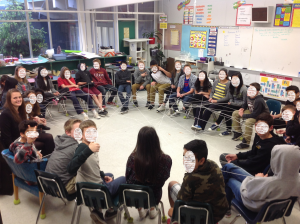
Web weaving circle activity, demonstrating our interconnections
Dialogue circles became a major part of my community-building action plan. Circles had come up in many contexts throughout my courses and initial practicum: for class meetings, daily check-ins, restorative justice, and subject specific dialogue to discuss, debate, or share learning. The concept was first introduced to me through an indigenous education leader, and I read further about circles in various resources. HavWeb weavining the class sit in circles allows for everyone’s face to be seen and each individual has a chance to speak and to be heard. The circle itself “represents the interconnectedness of all things (people, earth, moon, sun) […] bringing people of all ages together for the purposes of teaching, listening, and learning” (Running Wolf & Rickard, 2003). A talking circle is “seen as an effective tool that fosters respect, models good listening skills, settles disputes, resolves conflicts, and builds self-esteem” (Running Wolf & Rickard, 2003).
For me, having regular times to encourage full class dialogue was a crucial aspect to building the foundation of our community, setting new/revised classroom expectations, and taking a proactive approach to classroom management. Our first few talking circles were aimed at getting to know one another, and checking in on how the students felt about their learning. As the reflection above indicates, the class had difficulty respecting the rules of the circle; circles for dialogue and discussion were new to them, and they had been required to adjust to so much change already. In the circle, the students told me that they were very stressed about having to move their desks and chairs into circle formation, and they expressed a desire to only have circle time once in a while. As a group, we decided to have the circles a maximum of once per week, and we chose a time to do that (through reflection, the mornings seemed to be the most effective times for circle meetings).
“I noticed that having the meeting at the beginning of the day when they were calm meant they talked out of turn less and were more respectful towards one another. They brought up some great observations about the week. They noted what we did well and what goals we need to set for the upcoming week (talking less, listening more, and keeping the class clean). I think I should delegate a secretary to record our weekly goals and write them on the board somewhere so they can see them throughout the week” Week 6 of long practicum
We used much of our circle time discussing issues the students were having in class, and solutions to those concerns. I encouraged everyone to contribute to the discussions, though they always had the right to pass. The students mentioned that they struggled with all the different teaching styles and expectations, and requested that I teach in a more traditional way (straight forward instruction with tests as assessments) as it was something that was familiar. They found the integrated units, project based learning, and inquiry to be too overwhelming at this point in the year. As my primary concern was to create the best learning environment for them, I changed my approach. Their relief was palpable, and in their end of year letters to me, many expressed gratitude for the circles and for their voiced concerns being recognized and acted upon.
Despite regular circles of dialogue to promote classroom community and approach classroom management proactively, there were still many instances of disconnect between myself and the class as a whole. Consequently, classroom behaviour was a persistent challenge. I believe that if the class had started out with regular classroom circles, and continually touched base as a whole class, the circles would have been more effective in promoting self-discipline. As I came in with only a month of school remaining, there were only a few opportunities for circles of dialogue, and even less after the class voted to have them just once a week. In my future practice, I plan to introduce circles from the beginning and develop their use in the classroom consistently throughout the school year.
Of course, I do not believe circles of dialogue alone are enough to promote a strong sense of community. As indicated in my philosophy, I believe that key features of building classroom community involve giving the students a common goal to work towards, ensuring that each student is important and valuable towards the success of that goal, and having an inherent risk of failure (Linsin, 2009). To achieve this goal, and ultimately a collaborative classroom environment, I designed a French language project where the students were required to work together to design and create a country for our class. The project was inspired by the children’s book, How To Build Your Own Country, and at first generated enthusiasm among the students.
“The week started out great! The students seemed calm, and although they groaned at the idea of another project, were excited they got to choose which aspect of the project they got to do, and during at least one point in the day I saw students working on their part without being asked (it was a free block). I decided to use a deck of cards, hand out the cards, and allow the students to sign up as I called out random card numbers. It was orderly, and gave the students some choice in their project. The lesson went much longer than anticipated, and therefore I didn’t get around to the criteria or the assessment, but was able to include it into the circle meeting we had later in the day.” Week 6 of long practicum
The project itself was not perfect (as discussed in this section), but did make some contribution to the classroom community, even if that contribution was limited. I think the project had great potential to contribute to classroom community, however the time restraints impaired the effectiveness of the project. Instead of becoming a cross-curricular unifying project, it became an isolated activity that could not be integrated or referred to in other classes because time ran out.
Although the outcome did not have the effect I had anticipated, the project itself still promoted collaboration among all students. The groups had to work together to coordinate their efforts, and present their projects with a unified front. For example, the currency they designed contained images of both the lightning bolt from the country’s flag, and the country’s map, and portions of the country’s national anthem. Similarly, their passport was colour coordinated with the country’s flag.
Ultimately, I think my initial plan for the project was too ambitious. I had imagined the students finishing their projects in one week, and then building on the joint effort by integrating their projects into other classroom activities thereafter. Instead, the projects took double the time, and once they were fully complete and displayed on the walls there were limited opportunities to actively use what they had created. Ideally, this would be a project done at the beginning of the year, so there is ample time to integrate the students’ contributions to their fictional country.
Both the circles of dialogue and the collaborative project were attempts to proactively address classroom behaviour through the development of community. However, as the practicum continued, I began to realize that these long term, gradual approaches were not as effective in the short-term environment, as both the time constraints and end of year mentality were limiting factors. Ultimately, I began using more reactive approaches to behavioural management, such as incident specific dialogue with either individuals who were particularly disruptive or disrespectful, or with the class as a whole.
“After the incident occurred, I sat down with him and we talked about having to work towards regulating our own behaviour and regulating the behaviour of our group. We talked first about ways we could contribute to group regulation (as self-regulation is a harder thing to tackle), and he indicated that he could “shush” the group when they got noisy, and he could remind the others to be respectful.
During the next lesson, each time he contributed to regulating the group when they started to get out of control, I thanked them for the specific strategy he used, validating that he had correctly identified disrespectful behaviour. I will work on providing him with strategies to self-regulate next week.” Week 6 of long practicum
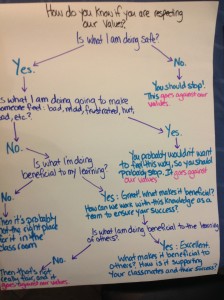
The students were highly engaged in the open dialogue, and contributed to great solutions for future self-discipline. The discussions highlighted their thinking process, and demonstrated that they were aware of what needed to be done to self-regulate their behaviour. However, their ability to actively act on their impulses was limited. As such, during one of our circle meetings, we made a behaviour flow chart. The aim of the chart was to scaffold their development of self-discipline through a series of questions and prompts. The poster was a great addition to refer to in the class, as it was co-constructed by the students themselves based on our co-constructed classroom values and expectations.
“The continual calling out and complaining had become a big issue during one of the integrated science classes this week. As a result, I stopped the lesson, sat down, and had a talk with them about how those comments affected me. I explained that the comments were hurtful, as I had put a lot of time and effort into preparing the lessons, and aimed to make them as engaging and interactive as possible. I told them that if the concern was genuine, and they thought that they needed to discuss an issue with me, calling out in front of the entire class is not the way to do it. It puts me on the spot, and the culmination of all the complaining is making me feel defeated. If they had a real issue, I encouraged them to speak with me privately after class. After having this talk, the complaints occurred less, and almost all the students stopped. For the remainder of the week, the students stopped complaining.” Week 6 of long practicum
The open dialogues, either on an individual or classroom level, although reactive and not proactive, were effective means of directly addressing specific behavioural concerns in the class. I believe that a solid combination of proactive and reactive approaches is required for successful classroom management and the maintenance of a positive classroom community.
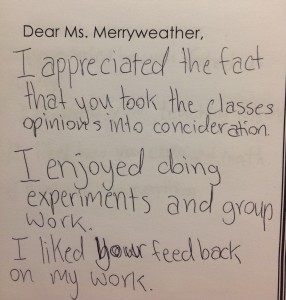
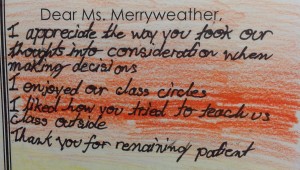
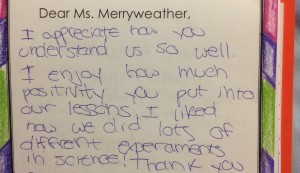



 Follow
Follow